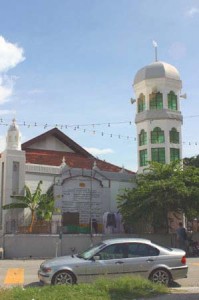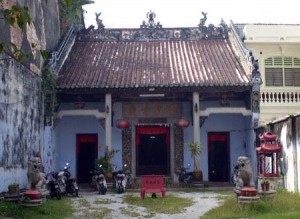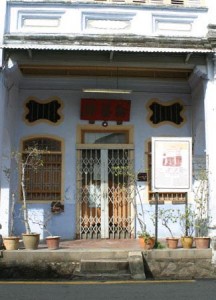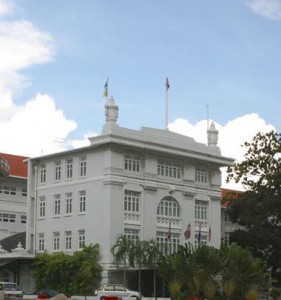George Town walking tour – Part 2
George Town, the capital of Penang and the second largest city in Malaysia, has one of the largest collections of 19th and 20th century buildings in SE Asia. The easiest way to see the old town area is on foot. Having completed Part 1, here’s Part 2 of a suggested walking tour (all images are clickable):
Having looked at Cheong Fatt Tze’s mansion, we headed southwards along Lebuh Leith, across Lebuh Muntri, to our next port of call, the Benggali Mosque, on the left hand side of the street.
 The Benggali Mosque is believed to have been founded in 1803, on a site granted by the East India Company during Leith’s term as Lieutenant-Governor of Penang. In the late 18th century Indians were brought over to Penang either as sepoys or convicts, and Light also brought out some Bengali farmers in an attempt to encourage agricultural enterprise on the island. Eventually the term “Benggali” came to apply to all who travelled overland to Calcutta and sailed to Penang.
The Benggali Mosque is believed to have been founded in 1803, on a site granted by the East India Company during Leith’s term as Lieutenant-Governor of Penang. In the late 18th century Indians were brought over to Penang either as sepoys or convicts, and Light also brought out some Bengali farmers in an attempt to encourage agricultural enterprise on the island. Eventually the term “Benggali” came to apply to all who travelled overland to Calcutta and sailed to Penang.
We left the Benggali mosque and retraced our steps as far as Lebuh Muntri, where we turned right (eastward). Walking along the street, we passed a couple of places offering backpackers’ accommodation, the type with dormitory beds and shared facilities. Pleasant enough if that’s what you’re into. Beware of the strawberry shake at No.75 – it tasted vile.
 Carrying on down Lebuh Muntri, we passed the Carpenters’ Guild temple on our right. This temple is dedicated to Lo Pan, the patron deity of carpenters. Many of Penang’s heritage buildings were built by members of this guild. In the 19th century all Cantonese builders coming from China would first call in to this Guild before proceeding to other parts of the peninsula to work. Many settled in Penang and passed on their ancient trade to their descendants, thus forming the backbone of the building trades today.
Carrying on down Lebuh Muntri, we passed the Carpenters’ Guild temple on our right. This temple is dedicated to Lo Pan, the patron deity of carpenters. Many of Penang’s heritage buildings were built by members of this guild. In the 19th century all Cantonese builders coming from China would first call in to this Guild before proceeding to other parts of the peninsula to work. Many settled in Penang and passed on their ancient trade to their descendants, thus forming the backbone of the building trades today.
We then turned right (south) at the crossroads into Lorong Love (Love Lane), and walked down as far as:
The Goldsmiths’ Guild, founded in 1832, is the oldest and largest guild for goldsmiths in Malaysia. The present temple on Lebuh Muntri was built in 1903, and is dedicated to Wu Ching, the patron deity of goldsmiths.
Backtracking again, we turned right (east) into Lorong Stewart, a narrow street. About halfway down the street we came to our next stop.
 The Hainanese Mariners’ Lodge accommodated itinerant mariners and some of their families. In 1998 the Penang Heritage Trust took a lease on the house and turned it into their base. Visitors are welcome to call in for information or to visit the gift shop. Again, it was closed on the day we visited due to a public holiday, so we can’t comment on the interior of the house. But you might as well pop in if you’re passing.
The Hainanese Mariners’ Lodge accommodated itinerant mariners and some of their families. In 1998 the Penang Heritage Trust took a lease on the house and turned it into their base. Visitors are welcome to call in for information or to visit the gift shop. Again, it was closed on the day we visited due to a public holiday, so we can’t comment on the interior of the house. But you might as well pop in if you’re passing.
We then turned back along Lorong Stewart, then right (northwards) up Love Lane towards its junction with Lebuh Farquhar at the end of the road. Turning right (east), on our right we passed:
The Cathedral of the Assumption, which was originally built as a church in 1861 and was elevated to cathedral status in 1955. Soon after Penang’s founder Captain Francis Light arrived on the island in 1786, he arranged for the first Roman Catholic community to be brought over by ship from Kuala Kedah. The original church, on Church Street, was founded by Father Garnault in 1786, and named the Church of Assumption because the first group of Catholics landed on the island on the eve of the feast of the Assumption. The church was moved several times before reaching its present site in Lebuh Farquhar.
Penang Museum is just a little further along Lebuh Farquhar and contains many interesting exhibits. Once again, we couldn’t go in because of the public holiday. However, we’ll be sure to have a look around next time we’re in Penang. The museum is open from 9am to 6pm six days a week (closed Fridays and public holidays).
Well, that’s the end of the walking tour, which should take an afternoon. It depends on how much time you want to spend in each place.
Our next stop was the Eastern & Oriental Hotel for a Penang Punch and an E & O Sling. Enjoy!


Leave a Reply